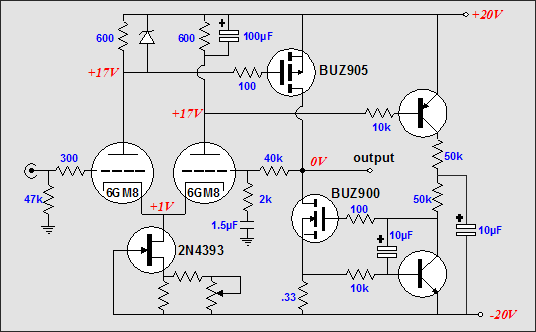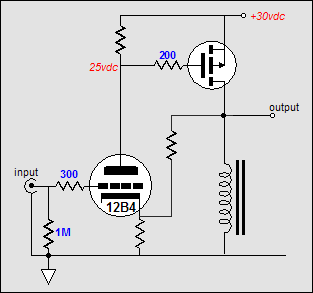|
††† It works quite well; the IDSS is about 10 mA and it sounds great with 300-ohm headphones. (If only there were some P-channel depletion-mode MOSFETs.) If 32-ohm headphones need to be driven, then the following circuits might be better choices.
†††††††††††††††††††††††††††††††††††††††††††††††† †††† †††††††††††††††††††††††††††††††††††††††††††††††††††††††††† |
|
††††††††††††††††††††††††††††††††††††††††††††††††††††††††††† Single-ended version††††††††††††††††††††††††††††††††††††††††††††††††††††††††† Push-pull version
More email on Ernoís amplifier topology †††† I had been collecting parts to build the tube-MOSFET hybrid amp for a while and came across your article in the March 2001 issue. I can't pretend to understand it but given the thought put in to each individual aspect of how and why this circuit works it would make more sense for me to build your revision and start from there. There are several parts that you have not identified on your final remake. Can you please give me the value of C1 and the unlabelled cap and diode in your revision? I have collected too many parts now to not build it. Also, would there be any component value changes should I opt to use 6 output devices instead of 4? Thank you for the time you put into explaining these circuits. Lee USA
†††† I cannot recommend building any variation of the circuit that was stolen from Erno Borbely (visit www.borbelyaudio.com). The two tricks that made the circuit attractive are low plate voltage and direct coupling. The problem, however, with the circuit is low plate voltage and direct coupling. The low plate voltage is incompatible with low distortion and the direct coupling is incompatible with safety, as at startup, huge DC offsets are likely. My recommendation is to build an amp that uses a separate high-voltage PS for the tubes and AC couple the tube to the MOSFET. Alternatively, you might experiment with a simpler version of the original circuit, one that forgoes using the current mirror. Below is a DC coupled amplifier that might prove safer, if the time constants are set to match the tubeís delay in heating up. |



|
††††††† But a better plan might be to use a more elaborate scheme wherein the output will not slam negatively when the tube fails or is removed from the powered circuit. In the circuit below, the bottom MOSFET relies on the tube to be conducting to energize its auto-bias circuit. If the triode is pulled out of its socket, the top transistor stops conducting and the bottom MOSFET loses its turn-on voltage.†† |

|
††† The simplest and possibly the best plan might be to do away with the active constant current source altogether and use an inductive load instead, as the efficiency of the amplifier will double and the amplifier will not destroy your speakers, if the tube is jiggled or removed from its socket. (If the chokeís DCR is higher than a third of an ohm, a coupling capacitor might be needed at the output.)
The end †† Well, before I get the urge to draw anymore schematics, letís stop here. Let me know if you like or dislike this blog style. (I expect quite a few of you will be disappointed that you cannot as easily print what you read.) †††††††††††††††††††††††††††††††††††††† ††††††††††††††††††††††††††††††††††††††††† //JRB |
